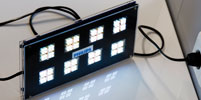Philips develops main-powered OLED module
27 October 2010
Opto-Electronics

Research scientists from Philips have developed the first ever organic light emitting diode (OLED) module that can be powered directly from a mains electricity supply. The prototype opens the door to OLED systems that can be directly plugged into standard power outlets without the need for bulky power management circuitry. This will reduce the bill of materials and simplify luminaire design for future OLED-based systems aimed at mass-market general illumination applications.
OLEDs offer a completely new vision of lighting. Like LEDs, OLEDs are solid-state lighting devices that are extremely efficient light emitters – thus helping reduce the financial and environmental costs of lighting. Next to LEDs offering very high brightness in a compact shape, OLEDs emit light over an extended area. The illumination they produce is ‘calm’, glowing and diffuse, and non-glaring. The thin, flat nature of OLEDs makes it possible to create light sources of a wide variety of shapes and sizes.
Moreover, OLEDs are fully dimmable and can produce many different colours as well as whites, including the kind of white light people appreciate from traditional light sources. This makes them an extremely attractive option for general illumination. However, until now, the physical characteristics of OLEDs have meant they have had to be powered from low-voltage direct current (DC) sources. In contrast, the AC-powered white-light module developed by Philips Research can be plugged directly into a mains wall socket.
Eliminating the need for driver electronics could bring many advantages for luminaire manufacturers. Because it reduces the number of components in a finished system, it makes system integration and assembly simpler, improves end-product reliability and enables faster time-to-market. What is more, it increases design freedom and expands the range of potential OLED applications.
Philips Research has developed its AC-powered module in collaboration with Dipl.-Phys. Holger Spahr, Institut für Hochfrequenztechnik, TUBraunschweig, Germany as part of the TOPAS 2012 project. This project, funded by the German, Federal Ministry of Education and Research (BMBF), brings together leading industrial and academic organisations to develop OLEDs for lighting systems of the future.
Further reading:
Versatile range of camera modules
EBV Electrolink
Opto-Electronics
The CAM-66GY pro-modules from ST are a full range of sample camera modules made for a seamless evaluation and integration of the VD66GY 1,5-megapixel colour image sensor.
Read more...
Enhanced breaker status and communication module
Schneider Electric South Africa
Opto-Electronics
Schneider Electric has announced the launch of its new Breaker Status and Communication Module (BSCM) Modbus SL/ULP, which delivers enhanced performance, improved connectivity, and simplified integration for power distribution systems.
Read more...
Heat-resistant LEDs
Opto-Electronics
Würth Elektronik’s new RGB LEDs are characterised by excellent heat resistance with an insensitivity to temperatures from -40 to 100°C making them ideal solutions for reliable, colour-variable lighting in applications at high operating temperatures.
Read more...
PhotoMOS relays
Future Electronics
Opto-Electronics
The AQY221R2SX and AQY221R2S PhotoMOS from Panasonic Industry ensures excellent characteristics and high-speed switching performance.
Read more...
Mouser now shipping onsemi’s image sensors
TRX Electronics
Opto-Electronics
The AR0145CS is a 1/4,3-inch CMOS digital image sensor with a 1280 (H) x 800 (V) active-pixel array that can capture both continuous video and single frames.
Read more...
Adaptive optics’ power solution
Altron Arrow
Opto-Electronics
Vicor power-dense adaptive optical modules enable colossal telescopes to look into the past for deep space discoveries.
Read more...
Ultra-high speed photo detection
Opto-Electronics
TDK Corporation has announced a photo-spintronic conversion element combining optical, electronic, and magnetic elements that can respond at an ultra-high speed of 20 picoseconds.
Read more...
High-speed lasers
RFiber Solutions
Opto-Electronics
Macom are a high-volume manufacturer of lasers, deploying more than 100 million devices with a reliability of less than 50 FIT and greater than 100 years of wear-out lifetime
Read more...
High-performance optical interconnect
Opto-Electronics
STMicroelectronics has unveiled its next generation of proprietary technologies for higher-performing optical interconnect in datacentres and AI clusters.
Read more...
Halo mid-board optical transceiver
Spectrum Concepts
Opto-Electronics
The Samtec Halo mid-board transceiver has been designed for next-generation embedded applications that require 56 and 112 Gbps PAM4 performance in low profile and ruggedised form factors.
Read more...


